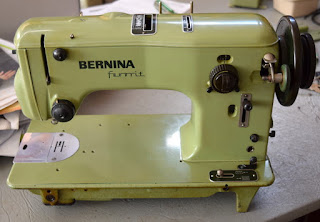The lesson I learned was that shortcuts will waste your time. If you care about the result, you'll rip out the seam, fix up the work and go back to the old techniques, which work. This technique is described in all the older sewing books and pattern instructions. Over time you'll do it automatically and although it takes a lot longer, it will be perfect.
The summary is that you make two parallel loose stitches inside the seam, the inner one quite close to it, and use the threads to gather up the ease evenly. Here are the instructions:
Loosen your machine's tension a bit and sew two lines of thread inside the seam allowance. I make them 1/4" (6mm) from the edge and 1/4" from there (inner one should be about 1/8" from the seam allowance). It doesn't actually matter if one is on one side of the S.A. and the other's just outside, it will still work.
Only stitch between the single notch (front of garment) and first of the double notch and use the longest stitch length.
 |
| Loosely stitched, longest length, between notches |
When you've done this the bottom threads will be a bit loose, so hold the thread ends and pull the fabric away so the sleeve gathers.
 |
| Hold looser threads, push fabric, smooth it out |
Re-set the tension for normal sewing (was loose for the gathering thread), remembering to:
1. Sew it on your machine, with the gathered side down at normal stitch length.
2. Sew very slowly and have your hands feeling the fabric before it is sewn and smoothing out the gathering.
3. Stop every few inches to check underneath, to ensure you don't sew anything else.
4. Check on the right side that it's perfect, and make corrections if it's not.
When finished, perform a check. Look for tucks/pleats, and if there are any, just unpick that area and re-stitch it.
If all is good you can now remove the gathering and basting threads.
I've sewn well over two hundred sleeves and this is how I get it right first time with no tucks. It takes a lot longer and some practice but you'll rarely have to reach for the seam ripper (at least for sleeves!) and your sleeves will be perfect.















































